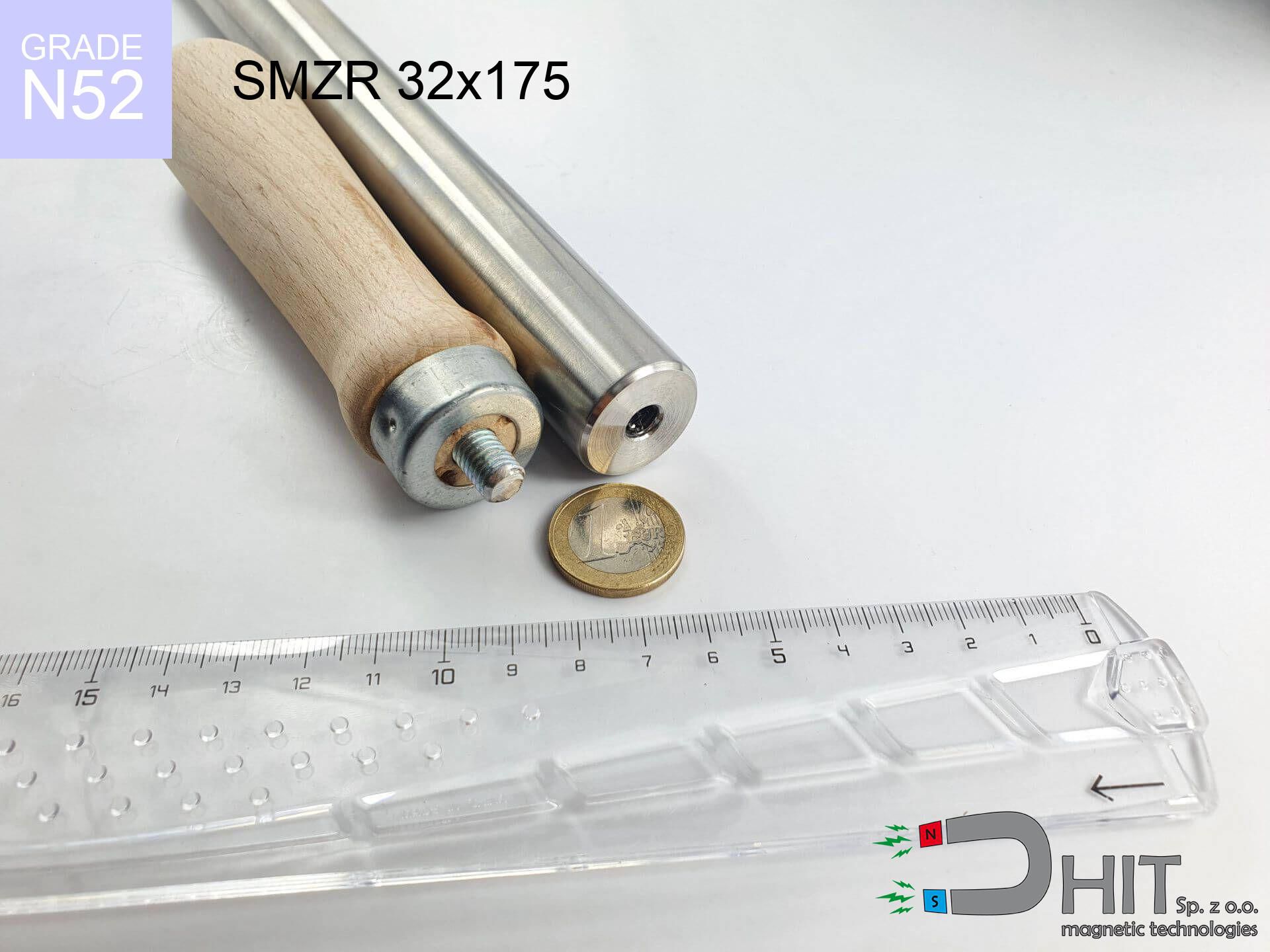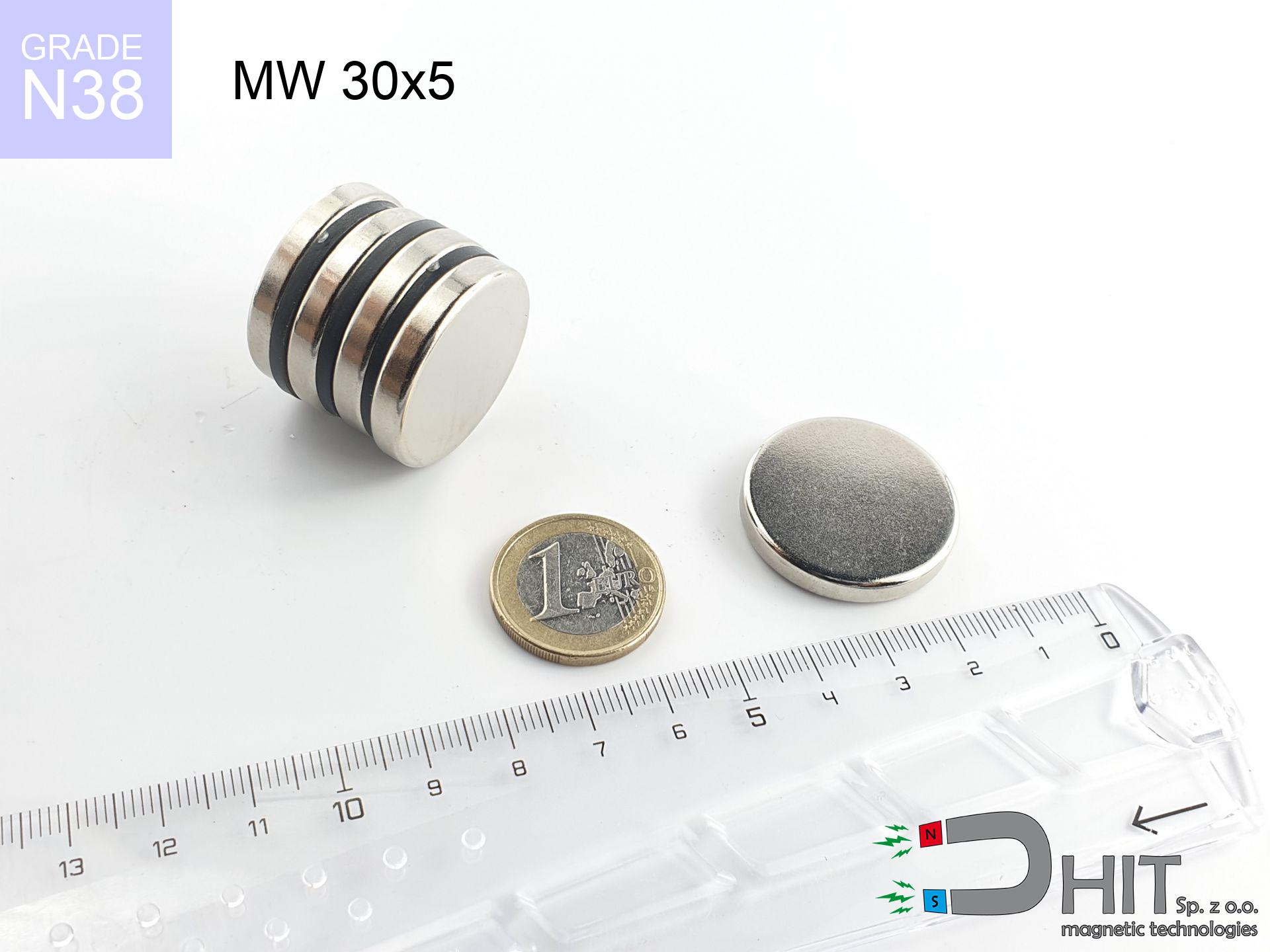SM 32x200 [2xM8] / N52 - magnetic separator
magnetic separator
Catalog no 130360
GTIN/EAN: 5906301813088
Diameter Ø
32 mm [±1 mm]
Height
200 mm [±1 mm]
Weight
1100 g
Magnetic Flux
~ 10 000 Gauss [±5%]
676.50 ZŁ with VAT / pcs + price for transport
550.00 ZŁ net + 23% VAT / pcs
bulk discounts:
Need more?
Give us a call
+48 888 99 98 98
if you prefer send us a note using
inquiry form
the contact section.
Parameters along with shape of magnetic components can be calculated on our
magnetic calculator.
Orders submitted before 14:00 will be dispatched today!
Detailed specification - SM 32x200 [2xM8] / N52 - magnetic separator
Specification / characteristics - SM 32x200 [2xM8] / N52 - magnetic separator
| properties | values |
|---|---|
| Cat. no. | 130360 |
| GTIN/EAN | 5906301813088 |
| Production/Distribution | Dhit sp. z o.o. |
| Country of origin | Poland / China / Germany |
| Customs code | 85059029 |
| Diameter Ø | 32 mm [±1 mm] |
| Height | 200 mm [±1 mm] |
| Weight | 1100 g |
| Material Type | Stainless steel AISI 304 / A2 |
| Magnetic Flux | ~ 10 000 Gauss [±5%] |
| Size/Mount Quantity | 2xM8 |
| Polarity | circumferential - 7 poles |
| Casing Tube Thickness | 1 mm |
| Manufacturing Tolerance | ±1 mm |
Magnetic properties of material N52
| properties | values | units |
|---|---|---|
| remenance Br [min. - max.] ? | 14.2-14.7 | kGs |
| remenance Br [min. - max.] ? | 1420-1470 | mT |
| coercivity bHc ? | 10.8-12.5 | kOe |
| coercivity bHc ? | 860-995 | kA/m |
| actual internal force iHc | ≥ 12 | kOe |
| actual internal force iHc | ≥ 955 | kA/m |
| energy density [min. - max.] ? | 48-53 | BH max MGOe |
| energy density [min. - max.] ? | 380-422 | BH max KJ/m |
| max. temperature ? | ≤ 80 | °C |
Physical properties of sintered neodymium magnets Nd2Fe14B at 20°C
| properties | values | units |
|---|---|---|
| Vickers hardness | ≥550 | Hv |
| Density | ≥7.4 | g/cm3 |
| Curie Temperature TC | 312 - 380 | °C |
| Curie Temperature TF | 593 - 716 | °F |
| Specific resistance | 150 | μΩ⋅cm |
| Bending strength | 250 | MPa |
| Compressive strength | 1000~1100 | MPa |
| Thermal expansion parallel (∥) to orientation (M) | (3-4) x 10-6 | °C-1 |
| Thermal expansion perpendicular (⊥) to orientation (M) | -(1-3) x 10-6 | °C-1 |
| Young's modulus | 1.7 x 104 | kg/mm² |
Table 1: Rod construction
SM 32x200 [2xM8] / N52
| Parameter | Value | Description / Unit |
|---|---|---|
| Diameter (Ø) | 32 | mm |
| Total length | 200 | mm (L) |
| Active length | 164 | mm |
| Section count | 7 | modules |
| Dead zone | 36 | mm (2x 18mm starter) |
| Weight (est.) | ~1222 | g |
| Active area | 165 | cm² (Area) |
| Housing material | AISI 304 | 1.4301 (Inox) |
| Surface finish | Ra < 0.8 µm | Polished |
| Temp. class | 80°C | Standard (N) |
| Force loss (at max °C) | -12.8% | Reversible loss (physics) |
| Force (calculated) | 41 | kg (theor.) |
| Induction (surface) | ~10 000 | Gauss (Max) |
Chart 2: Field profile (7 sections)
Chart 3: Temperature performance
Elemental analysis
| iron (Fe) | 64% – 68% |
| neodymium (Nd) | 29% – 32% |
| boron (B) | 1.1% – 1.2% |
| dysprosium (Dy) | 0.5% – 2.0% |
| coating (Ni-Cu-Ni) | < 0.05% |
Ecology and recycling (GPSR)
| recyclability (EoL) | 100% |
| recycled raw materials | ~10% (pre-cons) |
| carbon footprint | low / zredukowany |
| waste code (EWC) | 16 02 16 |
Other deals
Advantages as well as disadvantages of Nd2Fe14B magnets.
Pros
- They virtually do not lose strength, because even after 10 years the performance loss is only ~1% (in laboratory conditions),
- They maintain their magnetic properties even under external field action,
- A magnet with a smooth gold surface is more attractive,
- The surface of neodymium magnets generates a maximum magnetic field – this is a distinguishing feature,
- Thanks to resistance to high temperature, they are capable of working (depending on the shape) even at temperatures up to 230°C and higher...
- Possibility of accurate machining as well as adjusting to defined conditions,
- Significant place in innovative solutions – they are utilized in HDD drives, motor assemblies, advanced medical instruments, as well as modern systems.
- Thanks to concentrated force, small magnets offer high operating force, with minimal size,
Cons
- To avoid cracks under impact, we suggest using special steel holders. Such a solution protects the magnet and simultaneously increases its durability.
- When exposed to high temperature, neodymium magnets experience a drop in strength. Often, when the temperature exceeds 80°C, their strength decreases (depending on the size and shape of the magnet). For those who need magnets for extreme conditions, we offer [AH] versions withstanding up to 230°C
- When exposed to humidity, magnets usually rust. For applications outside, it is recommended to use protective magnets, such as magnets in rubber or plastics, which secure oxidation and corrosion.
- Due to limitations in realizing threads and complex forms in magnets, we propose using casing - magnetic mount.
- Potential hazard resulting from small fragments of magnets can be dangerous, when accidentally swallowed, which gains importance in the context of child safety. Additionally, small components of these devices are able to be problematic in diagnostics medical when they are in the body.
- High unit price – neodymium magnets have a higher price than other types of magnets (e.g. ferrite), which hinders application in large quantities
Holding force characteristics
Maximum holding power of the magnet – what contributes to it?
- using a sheet made of low-carbon steel, acting as a ideal flux conductor
- possessing a massiveness of at least 10 mm to avoid saturation
- with a surface cleaned and smooth
- without any clearance between the magnet and steel
- during detachment in a direction vertical to the mounting surface
- in neutral thermal conditions
Key elements affecting lifting force
- Air gap (between the magnet and the metal), as even a microscopic distance (e.g. 0.5 mm) can cause a drastic drop in force by up to 50% (this also applies to paint, corrosion or dirt).
- Angle of force application – maximum parameter is available only during pulling at a 90° angle. The force required to slide of the magnet along the surface is usually many times lower (approx. 1/5 of the lifting capacity).
- Base massiveness – too thin steel causes magnetic saturation, causing part of the power to be lost to the other side.
- Chemical composition of the base – low-carbon steel gives the best results. Higher carbon content decrease magnetic properties and lifting capacity.
- Base smoothness – the smoother and more polished the plate, the larger the contact zone and stronger the hold. Unevenness creates an air distance.
- Temperature – temperature increase results in weakening of force. Check the maximum operating temperature for a given model.
Holding force was tested on the plate surface of 20 mm thickness, when a perpendicular force was applied, whereas under parallel forces the lifting capacity is smaller. Moreover, even a minimal clearance between the magnet’s surface and the plate decreases the load capacity.
Precautions when working with NdFeB magnets
Safe operation
Before use, read the rules. Uncontrolled attraction can destroy the magnet or hurt your hand. Be predictive.
Electronic devices
Powerful magnetic fields can erase data on credit cards, HDDs, and other magnetic media. Keep a distance of at least 10 cm.
Life threat
Patients with a pacemaker must keep an absolute distance from magnets. The magnetism can stop the operation of the implant.
Precision electronics
A powerful magnetic field interferes with the operation of magnetometers in phones and GPS navigation. Maintain magnets close to a smartphone to prevent breaking the sensors.
Allergic reactions
Certain individuals have a sensitization to Ni, which is the standard coating for neodymium magnets. Prolonged contact can result in an allergic reaction. It is best to wear safety gloves.
Bodily injuries
Large magnets can crush fingers instantly. Do not place your hand betwixt two attracting surfaces.
Dust explosion hazard
Mechanical processing of neodymium magnets poses a fire risk. Neodymium dust reacts violently with oxygen and is difficult to extinguish.
Heat warning
Avoid heat. Neodymium magnets are sensitive to heat. If you require operation above 80°C, inquire about HT versions (H, SH, UH).
Swallowing risk
Strictly keep magnets away from children. Risk of swallowing is high, and the effects of magnets connecting inside the body are tragic.
Magnet fragility
Protect your eyes. Magnets can fracture upon uncontrolled impact, launching sharp fragments into the air. Wear goggles.

![Separation magnetic rod SM 32x200 [2xM8] / N52 Separation magnetic rod SM 32x200 [2xM8] / N52](https://cdn3.dhit.pl/graphics/banners/magnet.webp)
![SM 32x200 [2xM8] / N52 - magnetic separator](https://cdn3.dhit.pl/graphics/products/sm-32x200-2xm8-tus.jpg)


![SM 25x125 [2xM8] / N52 - magnetic separator SM 25x125 [2xM8] / N52 - magnetic separator](https://cdn3.dhit.pl/graphics/products/sm-25x125-2xm8-bub.jpg)


